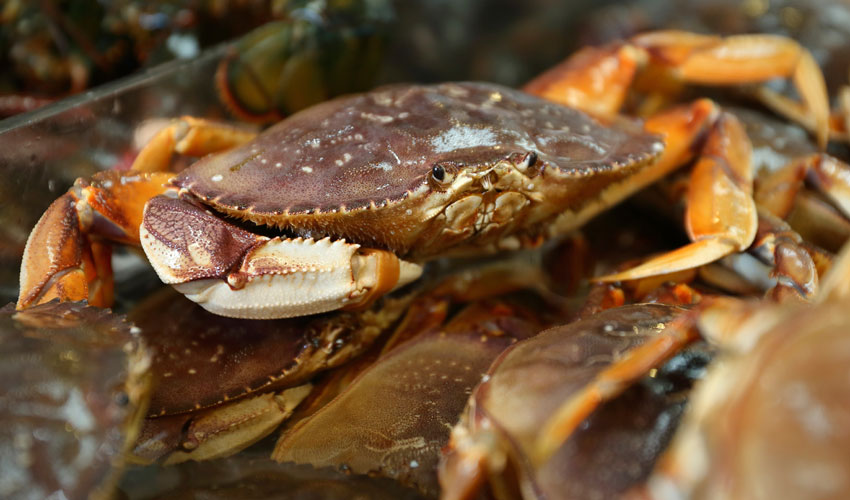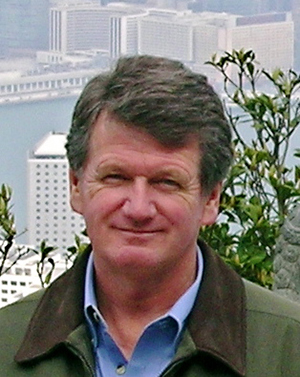What's a 'toxic algal bloom'? SF State expert explains

Dungeness crabs, a popular dish during the holiday season, feed on clams, mussels and other crusteaceans and small fish that in turn feed on toxic algae, making the crabs dangerous for humans to eat.
Bay Area crab enthusiasts were dismayed to hear last week that this year's crab season is on hold thanks to a "toxic algal bloom" that is making crabs unsafe for human consumption.
A "toxic algal bloom" is the result of the rapid growth of an algal species that produces a biotoxin or phycotoxin, says William Cochlan, a senior research scientist at the Romberg Tiburon Center and a research professor of biology at San Francisco State University who has extensively researched harmful marine algae, including the primary species behind the current bloom, Pseudo-nitzchia australis.
The situation has caused California state officials to delay the start of commercial crab fishing, putting a $60 million industry at risk just as the holiday season is starting. Below, Cochlan answers some basic questions about the science behind toxic algal blooms, and why they have put the pinch on an annual tradition.
 What is causing the current bloom?
What is causing the current bloom?
The current bloom is caused by a common group of algae that belong to the general algal division called diatoms. These specific diatoms are toxigenic, and belong to the genus Pseudo-nitzschia. In this case, the diatom species primarily responsible is Pseudo-nitzschia australis, although other diatoms belonging to this genus are also found in much lesser densities in the bloom.
We refer to them as toxigenic because they are capable of producing the phytotoxin Domoic acid -- a secondary amino acid that is water soluble and bioaccumulates in filter-feeding organisms -- mussels, clams, oysters -- and plankton-eating fish such as anchovies and sardines, though it is not always the case that they do produce Domoic acid.
Why is it making crabs dangerous to eat?
Dungeness crabs naturally eat clams, mussels and other crustaceans as well as small fish. The crabs have been eating these contaminated filter-feeding marine organisms that have accumulated cells of Pseudo-nitzschia–containing Domoic acid, and the crabs have not had enough time to rid themselves of this toxin through a natural process called "depuration."
Is this related to climate change?
So far the only environmental factor that has been identified to coincide with this massive bloom of Pseudo-nitzschia cells has been increased water temperature. Nothing else has yet been examined in detail, although studies are ongoing at SF State and elsewhere.
The increase in water temperature is due to the El Niño weather pattern currently present along the coast of California. In addition, the influence of the anomalously warm "blob" of water offshore in the North Pacific Ocean is thought to contribute to the increased coastal water temperatures, especially as one travels farther north to Oregon and Washington. So the warmer water is not necessarily due to climate change, but as Dr. Nick Bond at the University of Washington has suggested, it is perhaps a "dress rehearsal" that is producing conditions that will likely be more common with global warming.
Is this a temporary situation, or should we expect to see this continue long term in this area?
The blooms of Pseudo-nitzschia have already begun to decline, and will continue to decline with the more turbulent and cooler conditions of winter. Both the water temperature and the amount of sunlight that the phytoplankton needs to photosynthesize will decrease, slowing its growth. The blooms will be replaced by other, non-toxic phytoplankton in the area that out-compete the Pseudo-nitzschia cells for the resources needed for growth, including nutrients and trace elements in the sea.
Once Pseudo-nitzschia becomes more rare, filter-feeding organisms like crabs will naturally depurate themselves of Domoic acid, and will become safe to eat again once their concentration of the biotoxin per tissue weight is below regulatory limits. However, it may take weeks to months before Dungeness crabs are safe to eat once again.
How will this impact your holiday plans?
This will not impact my holiday plans. However, it must be very difficult for the people who depend on this marine fishery for their livelihood. As a marine scientist who specializes in researching toxic phytoplankton species, I hope we will have the resources to tackle this issue in an efficient and timely manner, since such toxic blooms negatively impact not only the marine ecosystem, but also the well-being of many, many people in California and elsewhere, including the indigenous people of the Pacific Northwest and Alaska who are dependent on subsistence shellfish fisheries for traditional use.